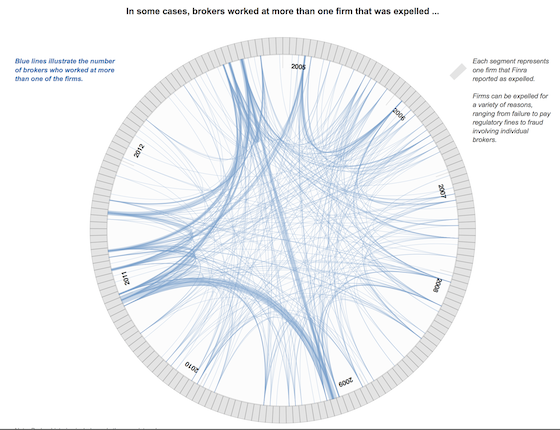The Wall Street Journal has an excellent investigative series going into Wall Street self-regulator FINRA and how its system of investor protection allows brokers to hide red flags they’re supposed to report.
If you’re paying someone managing your money or giving you investment advice, you probably want to know whether they can run their own finances. You can do background checks on brokers through FINRA’s BrokerCheck site.
FINRA wouldn’t give the Journal access to its database, which is in itself a story. If the government is going to outsource regulation to private entities (FINRA, by the way has a budget that’s half that of the SEC’s), it might want to have them covered under the Freedom of Information Act.
The Journal‘s Jean Eaglesham and Rob Barry got around this, though, with some great enterprise reporting: The paper filed open-records requests in 50 states and got records on 558,000 brokers—about 88 percent of all brokers nationwide—from 21 of them.
It found at least 1,500 brokers across the country whose post-2004 bankruptcies didn’t show up on BrokerCheck. Now, you might think that’s a tiny number out of more than half a million brokers. It’s just 0.3 percent of the brokers the Journal examined.
The bankruptcy rate for all Americans over the last decade has averaged about 0.4 percent a year. Back out repeat filers and kids and that means roughly 3 percent of the population has declared bankruptcy since 2004.
So FINRA is missing roughly one in ten of its brokers’ bankruptcies, assuming financial advisors file at the same rate as the general population (do they? That could be an interesting next use of the WSJ’s new database). That’s a big deal.
The Journal also uses its data to show that bankruptcy-filing brokers are far more likely to have other problems on their records, including criminal charges and customer complaints.
This isn’t the first major story the WSJ has gotten from its database. In October, Eaglesham and Barry had a fascinating story that there are more than 5,000 stockbrokers whose firms were shut down by FINRA that are still working in the industry, a phenomenon called “cockroaching” in the industry. The Journal led with this anecdote:
Regulators expelled the first brokerage firm where Kenneth Dwyer sold securities. They did the same to his third, fourth, seventh and eighth. His 10th closed in June after regulators accused it of fraud…
Regulators on Sept. 30 suspended Mr. Dwyer for nine months and fined him $10,000, for allegations that included excessive trading, filings show. Mr. Dwyer agreed to the sanctions without admitting or denying wrongdoing.
The WSJ put together this brilliant graphic for the October story showing the more than 600 brokers who ended up at two or more firms FINRA ultimately shut down. It’s like an interactive six degrees of Glengarry Glen Ross:
Here’s how the Journal put it:
Some of these brokers appear to create bonds that bring them together repeatedly at firms that regulators later expelled. Mr. Dwyer, after his first brokerage job in 1998, would cross paths at other firms with contemporaries from his first job; at least one broker from his first firm was with him at his 10th.
The paper followed that piece up with one reporting also in October on an outside study that showed FINRA expunges customer complaints from the records of the vast majority of brokers who ask it to do so. Settling a case implies some acknowledgment of guilt, but in 98 percent of them in 2011, the brokers got the original customer complaint expunged from the record. That’s a very serious problem.
Today, Eaglesham and Barry follow with another report on somebody else’s smart study, one that says FINRA deletes brokers’ red flags:
The red flags that can be accessed in some states – but not from Finra directly – include information about whether a broker was ever under internal review “for fraud or wrongful taking of property, or violating investment-related statutes, regulations, rules or industry standards of conduct,” the study said.
Other potential black marks scrubbed from BrokerCheck include whether brokers have previously failed industry qualification exams, federal tax liens that have now been satisfied and personal bankruptcy filings that are more than 10 years old, according to PIABA.
This series is first-rate work on a bread-and-butter issue for Journal readers and for a good chunk of the general public too. Individually and together, these stories raise serious questions about Wall Street’s self-regulator—including whether this critical component of investor protection should be left in private hands at all.
Ryan Chittum is a former Wall Street Journal reporter, and deputy editor of The Audit, CJR’s business section. If you see notable business journalism, give him a heads-up at rc2538@columbia.edu. Follow him on Twitter at @ryanchittum.

